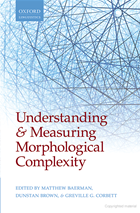Morphological complexity: Typology as a tool for delineating cognitive organization
Research areas
Research activity within the Morphological Complexity project includes a number of case studies and areas of particular concentration.
Complex inflection class systems
Since Wurzel (1984) and Carstairs (1983), the structure of inflection classes has come to play an ever more prominent role in morphological theory. The particular relevance of inflection classes lies in their being an instance of pure morphological structure, in as much as inflection classes, as traditionally and canonically understood, are arbitrary form based classes, and not exponents of some syntactic or semantic distinction. Perhaps of most interest are suggestions that there is a shared set of organizational principles behind inflection classes across what are unrelated and, at least superficially, profoundly different systems. At the core of these suggestions is the idea that in spite of their potential for great formal complexity, inflection classes tend towards an efficient organization that allows the generation of paradigms on the basis of relatively little prior information.
However, we find languages in which the distribution of inflectional allomorphy across lexemes appears, at least superficially, to defy treatment in terms of discrete inflection classes. Rather, individual zones of allomorphy cross-classify to yield scores or hundreds of distinct paradigm types. The analysis and elucidation of such systems has been a concern focus of the project, with particular focus on the Oto-Manguean languages (lately also in conjunction with the SMG's project on inflection classes in Oto-Manguean), the West Nilotic language Nuer, the Finnic language Võro (a variety of South Estonian), along with ongoing studies of Seri (a language isolate of Mexico) and Kadiwéu (a Guaicuruan language of Brazil).
Discovering and learning morphological complexity
Morphological complexity is a particularly challenging area when it comes to testing our theories. Because ‘unmotivated’ structure is difficult to account for in terms of other linguistic layers, an approach to validation based on independent analysis of the underlying data is of particular interest. Consider a morphological theory which claims that the lexemes of a language divide into several inflectional classes. How can we test the validity of such a theory? If we compare our theory with independently observed structure in the language data, this provides a more objective test of the theory’s validity. Together with Roger Evans (Brighton) a compression-based approach has been tested on both affixal and prosodic structure. The work has been presented at the Workshop "Morphological Complexity: Implications for the Theory of Language" at Harvard, the HPSG 2010 Workshop on Morphology and Formal Grammar in Paris, and as an invited plenary talk at the 14th International Morphology Meeting in Budapest, among other locations. Even given high frequency data containing many aberrant members of the recognized inflectional classes it is still possible to assign lexemes to these classes, suggesting some degree of validity for positing such autonomous classes (see Brown, Dunstan and Roger Evans. 2012. Morphological complexity and unsupervised learning: validating Russian inflectional classes using high frequency data. Current Issues in Morphological Theory:(Ir)regularity, Analogy and Frequency. Selected Papers from the 14th International Morphology Meeting, ed. by Ferenc Kiefer, Mária Ladányi and Péter Siptár, 135-62. Amsterdam: Benjamins.)
Greek noun inflection
Works in historical linguistics sometimes appear to suggest, or even assume, a general diachronic tendency towards morphological simplification in inflectional systems, particularly in respect of some types of analogical change, which is motivated by factors within the inflection system itself, rather than being imposed by external factors such as sound change. However, there has been little investigation into how this notion of simplification should be interpreted with respect to recent notions of morphological complexity. Greek has a particularly prolifically-studied history, with the details of the diachronic changes which occurred at various stages in the evolution of the language from its reconstructed Proto-Indo-European origins through to the Modern language already well understood, and this makes it well-suited as a case study for exploring this question. Scott Collier’s PhD thesis, The evolution of complexity in Greek noun inflection, takes a holistic approach in attempting to understand the evolution of this particular morphological system as a system. The diachronic changes which have occurred within the Greek noun declensions are modelled within the framework of Network Morphology, and the relationship is explored between these changes – and, in particular, those changes which appear to be motivated by factors internal to the inflectional morphology – and existing notions of entropic and principal-parts-based complexity.
Verbal inflection in Maltese
Traditionally Maltese verbs are classified on the basis of an underlying representation that assumes a consonantal root analysis for the Semitic verbal lexicon vs. a stem that characterises the non-Semitic based lexicon, which in turn brings about an asymmetry across the verbal lexicon. The Maltese verbs are in this study unified on the basis of stem pattern classes, where in keeping a uniform inflectional class, unlike the distinct inflectional classes posited in some literature on the language, paradigms take distinct patterns of stem-form alternations within them. The non-canonical behaviour of these stem-forms that alternate internal to the paradigm render patters that are generalised within stem pattern classes on the basis of which these are then grouped in parallel with what one finds in inflectional class classifications based on the affixes involved.
By considering stem pattern classes in Maltese we do not merely get to a surface-based and unified interpretation of the verbal lexicon, but these same accounts are taken as instances from where to observe morphological complexity, understood as a complexity akin to the morphological component that is not conditioned by other components in the grammar. The complexity observed in the inflectional verbal paradigm in the language involves stem-form alternations that are not derived as a result of morphotactic contexts, but are rather derived out of cell-induced changes. Through such patterns we also observe the non-canonical behaviour of the realization of inflection in the language. What we see is that as a result of a non-canonically alternating stem-form, inflectional/grammatical information is not realized solely by the affixal material, but the stem-forms themselves behave as exponents; non-affixal exponents that simultaneously with the affixal material, but realizing complementary and/or overlapping features, also realize grammatical information, and not solely the lexical information which they are canonically expected to realize.
Network Morphology
Network Morphology is the name of a framework for representing theories of morphological structure. Irregularity is treated in terms of default inheritance and construed as a matter of degree. An articulated notion of default is employed with a distinction made between the normal, or usual, case default and the exceptional case default. A recurrent pattern that we can observe is that the exceptional case default often involves a resort to a basic rule. The framework also distinguishes varying degrees and types of morphological autonomy. The heritage of Network Morphology goes back to a paper published by Greville Corbett and Norman Fraser 1993. Another major milestone was the implemented treatment of different types of syncretism in Baerman et al. (2005). The main book-length exposition of the theory is Brown and Hippisley (2012). In particular, this book presents detailed discussion of what sets the framework apart from other theories, as well as an exposition of the principles underlying the creation of different types of hierarchy. In recent applications of the framework models of inflection have been created which combine principal parts, implicational rules and default inheritance, measuring complexity by the number of overrides in the lexical entry (see Baerman 2012). Current work also applies Network Morphology to the analysis of change in inflectional classes (Scott Collier).
Stem alternations in possessed noun paradgims
In some languages, when a noun is overtly or implicitly possessed, the person of the possessor is morphologically expressed, either inflectionally (e.g. Turkish abla ‘sister’ ~ abla-n ‘your sister’) or lexically, through the use of a distinct lexeme (e.g. Japanese tsuma ‘(my) wife’ ~ okusan ‘(someone else’s) wife’). Intermediate between these two types we find examples such as Southern Pomo ʔa:-č’e-n ‘my mother’ ~ me-hṭʰe ‘your mother’, which has regular pronominal prefixes alongside the distinct lexical roots č’e and hṭʰe (Walker 2010). This hybrid phenomenon has been noted a number of times before (Merlan 1982, Dahl & Koptjevskaja-Tamm 2001, Drossard 2004, Ortmann 2006, Vafaeian 2010), with most accounts suggesting that it involves the substitution of a special term (typically a ‘nursery language’), yielding a 1st person ~ non-1st person suppletive pattern. But so far our knowledge is restricted to scattered examples. The current pilot cross-linguistic study focusses on the languages of New Guinea, which are particularly rich in examples.
Splits
When words have multiple forms, we might expect the simplest outcome: they could all follow the same pattern. Thus the English verb load has load-ed, load-s, load-ing. This appears to be efficient: the stem stays the same (which is good for recognition) and the inflectional forms vary. But many words are not like this; for example, there is go, went, goes, going. This verb is split, in the sense that the past tense form went does not follow the pattern of the other forms. The SMG has done intensive research on the phenomena which induce such splits (in the case of go ~ went it is suppletion). This new research looks rather at the nature of the splits: Where can splits be found? Do they follow an external pattern, or can they have no such motivation? Do they have any relevance outside the word? The basic idea has been aired at various meetings, including in an invited paper at OxMorph 3: Workshop on The Morphological Expression of Number (University of Oxford,). This research joins up with a previous interest on hybrid nouns (those whose agreements are not consistent, but which vary according to the agreement target, as we find with English committee). It turns out that almost all hybrids are also split, in that their special behaviour is found only for a part of their paradigm (on this see: Enger and Corbett, 'Definiteness, gender and hybrids: evidence from Norwegian dialects', to appear in: Journal of Germanic Linguistics 24.4), and Corbett’s paper at the Marburg Workshop "Agreement from a diachronic perspective" (October 2012).
Another area of interest involves paradigms where asymmetry in agreement for one feature has the supplementary effect of distinguishing values of another feature. We have identified a number of languages where values of person are distinguished through the presence or absence of gender marking, in particular in Tucanoan and Daghestanian languages, as well as the Kadugli language Krongo.
Project members
Prof Greville G. Corbett
Dr Matthew Baerman
Prof Dunstan Brown (University of York)
Dr Scott Collier
Dr Maris Camilleri
Period of award:
February 2009 - January 2015
Funder
European Research Council (ERC)
TOP




